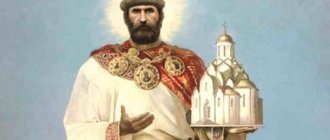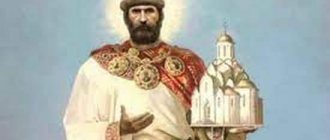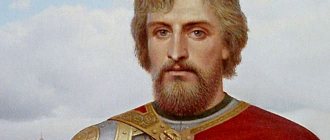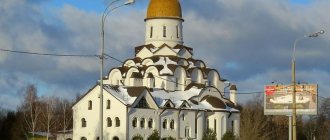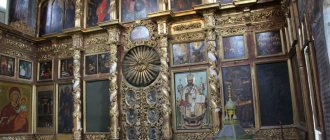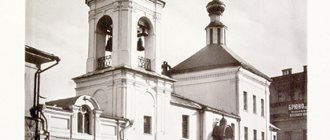The Russian Orthodox Church, long ago separated from the state structure and deprived of the status of a structural element of our state, does not exist in isolation from it. Their mutual influence and interaction is due to their location on a single territory and the unity of the population. Therefore, the state and the clergy have always had and will have mutual influence on each other. It does not ignore the reward system of both structures. The Order of Sergius of Radonezh is one of the striking examples of their interaction and common interests on the scale of their native Fatherland.
Description
The order has three degrees.
1st class
The badge is a nickel silver Byzantine cross (with truncated beams towards the center and slightly concave outer sides). In the center of the cross is a white gilded enamel embossed waist-length image of St. Daniel in an oval with an image framed by two palm branches with dark blue enamel. On the wide ribbon connecting the laurel branches, indicate the size of the Order. On the branches of the cross there are gilded letters of Church Slavonic letters at the top: - “faithful” on the left - “KNZ” on the right - “DANIEL” below - “ISKCON” (“Pious Prince Daniel of Moscow”) along the diagonals of the cross, four crowns are adjacent to the oval with a pattern, each of which is decorated with rhinestones and ends with a four-armed cross. At the top of the sign is a heraldic trefoil.
On April 14, 2006, the Patriarch and the Holy Synod made changes to the statute of the Order:
With this award, the Order of the 1st class, Heads of Churches and Heads of State are awarded Merit, the Order, a silk moire ribbon and an orange pendant on the ribbon.
2nd class
The badge is similar to the 1st class badge, but is made of silver-plated cupronickel. Instead, the crowns are rays emanating from the center. The central image of the background of St. Daniel and the frame of the socket, with a ribbon with the symbol of the II degree, is gilded.
3rd grade
The badge is similar to class 2, but is made using the blackening technique. The central image of the laurel branches of St. Daniel is framed in blue enamel and depicts a ribbon with the III degree badge.
The system of awards of the Russian Orthodox Church
Over the past decades, the hierarchy of the Russian Orthodox Church has created a system of orders and medals that commemorate the feat and contribution of our contemporaries - clergy, clergy and laity - to the cause of the revival of Russian Orthodox spirituality, for the benefit of the faith and the Fatherland. To date, this system includes eight orders of various degrees and three medals. In addition, special insignia may be established by the Holy Synods of the Belarusian and Ukrainian Autonomous Churches. Thus, clergy and laity of fraternal Belarus are awarded the Order of the Cross of St. Euphrosyne of Polotsk.
Orders and medals of the Russian Church can be awarded to any of its members regardless of rank, origin, property or class qualifications. The metropolitan and the rural priest, the learned theologian and the humble employee of educational and medical institutions, the priest and the layman - the reward of each is determined by his work and faith, and not by rank and social status. As it is said in the famous Easter conversation of St. John Chrysostom, the one who came to the field of church feat not in the morning, but from noon, and not even from noon, but only in the evening, and even, like many of us, “at the eleventh hour” , i.e. in his declining years, he is equally pleased and equally rewarded. It is never too late for anyone to join the great common work of the Holy Church.
In ancient times, the Russian Church did not know any system of external distinctions and awards. The intensity of spiritual life in dioceses and parishes was then completely different, incomparable with our modern era. Later, during the period of Imperial Russia, with its external splendor, “table of ranks” and a developed hierarchy of regalia, representatives of the clergy were awarded in accordance with the general order. Of course, the Church had and still has its own special reward system, based on the characteristics of the priesthood, liturgical attire and accessories of the clergy. The very appointment of a higher rank is a reward conditioned by the merit of the service of the recipient. A priest can become an archpriest, a hieromonk can become an abbot and archimandrite, a bishop can become an archbishop and then a metropolitan. A deacon may be awarded the right to wear a double orarion, a priest (and hieromonk) - a legguard, a pectoral cross, an archpriest - a club, a cross with decoration, a miter, the right to serve at the open Royal Doors to the Cherubim and to the Lord's Prayer, an archimandrite - the right to use a staff during divine services , archbishop - with a personal or memorial panagia...
But, in addition to these church and liturgical differences, the hierarchy of the Russian Church has developed in the last four decades a unique order system of church awards. The first to be established was the Order of Saint Equal-to-the-Apostles Prince Vladimir (three degrees), which appeared in our Church during the period of the primacy of His Holiness Patriarch Alexy I, in the late 1950s, and for a long time remained the only church award. Under His Holiness Patriarch Pimen, the Order of St. Sergius of Radonezh was established in 1978. Ten years later, in 1988, in commemoration of the 1000th anniversary of the Baptism of Rus', three orders were established at once: the Order of St. Apostle Andrew the First-Called with a diamond star, which became the highest award The Russian Orthodox Church, which is awarded to the Heads of Churches, the Order of the Holy Blessed Prince Daniel of Moscow, which was equally often awarded to both ecclesiastical and secular figures who have worked in the field of the spiritual revival of Russia, and the Order of the Holy Equal-to-the-Apostles Princess Olga - especially for church workers, ascetics of the Church and spiritual enlightenment.
In view of the need to encourage the contribution and heroism of people who devote their strength to the fight against the various spiritual and social ills of our society, charity and care for the weak and in need of help, the Order of the Holy Martyr Tryphon was established (in 1995) and - together with the Russian Children's Fund - Order of the Holy Blessed Tsarevich Demetrius (in 1997).
The revival of missionary service, the goal of which is now no longer the enlightenment of external, pagan peoples, but the return to Christ and the churching of the bulk of our people, prompted us to also establish a special missionary order - St. Innocent, Metropolitan of Moscow and Kolomna (1999). In addition to the indicated orders, we also award clergy and clergy and laity with church medals: St. Sergius of Radonezh, Blessed Prince Daniel of Moscow and St. Innocent, Metropolitan of Moscow and Kolomna.
...It is not the order that makes a person. And none of us will come with orders and medals to the Last Judgment of Christ. But clergy wear with dignity the awards assigned to them by the clergy as evidence of worthy completion of church service and respect from the flock and church people.
Order of the Holy Apostle Andrew the First-Called
In memory of the 1000th anniversary of the Baptism of Rus', the Holy Synod of the Russian Orthodox Church established three new orders on December 27-28, 1988: the Holy Apostle Andrew the First-Called with a Diamond Star, the Holy Blessed Prince Daniel of Moscow of three degrees and the Holy Equal-to-the-Apostles Princess Olga, also of three degrees. The Holy Apostle Andrew (November 30/December 13) is called “first-called” because he became the first of the Savior’s apostles. Immediately after the baptism of Christ on the Jordan, when John the Baptist pointed to Him as the Messiah, the Savior of the world, Andrei, forgetting about everything and leaving everything, followed the Teacher. For the Russian Church, the memory of the apostle is also important because, according to the chronicle, Apostle Andrew the First-Called was the first to bring the proclamation of the Christian faith to the borders of our Fatherland, visited Kyiv and Novgorod, and blessed the Christian future of the Russian Land.
Previously, in the Russian Empire, there was the Order of St. Andrew the First-Called, established by Peter the Great in 1698 and revered as the main one among Russian orders. Likewise, today the Order of St. Andrew the Apostle is the highest award of the Russian Orthodox Church. The diamond star of the order is worn on the right side in the upper part of the chest, and the badge of the order on a ribbon is worn over the left shoulder and is located under the star of the order; all other orders are worn lower. In the center of the order is the image of the holy apostle with the characteristic oblique (“St. Andrew’s”) cross on which the apostle was crucified. The original surviving parts of the cross, as well as the relics of the saint, are located in the Cathedral of St. Andrew in the Greek city of Patras. The Order is a Patriarchal award; it is awarded to persons only by decision and initiative of the Patriarch of Moscow and All Rus' and the Holy Synod.
Order of the Holy Equal-to-the-Apostles Grand Duke Vladimir
The Order of St. Vladimir of three degrees is the oldest in terms of establishment in the Russian Orthodox Church. It was established in 1957 to commemorate the 40th anniversary of the restoration of the Patriarchate in the Russian Church. Initially, it was modestly called “a breastplate in honor of the Holy Equal-to-the-Apostles Grand Duke Vladimir” and was intended to be awarded primarily to representatives of foreign Orthodox Churches and heterodox denominations.
...Historians called him the Great, the Church - Saint Equal to the Apostles, the poetic memory of the people - Vladimir the Red Sun. Grand Duke Vladimir Svyatoslavich (960-1015; commemorated July 15/28) managed to create a single powerful Holy Rus' from a conglomerate of disparate tribes and principalities. His main spiritual feat was the Baptism of Rus' in 988. The prince did not impose a new religion on the people: he sent ambassadors to different countries to “test their faith,” and when the messengers returned, he listened to them in a meeting of elders and people and, with conciliar consent, chose the Orthodox faith - according to the criterion of true beauty and grace. “For,” said the ambassadors, “when we stood at the service in the Cathedral of St. Sophia in Constantinople, we did not know where we were - in heaven or on earth.” The Baptism of Rus' predetermined the moral character and historical path of our people for a thousand years to come.
The first awards of the order (then still called the “badge”) took place in the spring of 1958. Among the persons awarded the order of the 1st degree in 1959 were Metropolitan Elijah Karam of the Lebanon Mountains and Emperor Haile Selassie I of Ethiopia.
The first Russian person to receive a high award was His Holiness Patriarch Alexy I of Moscow and All Rus'. The Order of St. Vladimir \ degree was awarded to him on July 18, 1961, on the day of the celebration of the memory of St. Sergius of Radonezh, at the Council of Bishops held in the Trinity-Sergius Lavra . The order could also be awarded to churches, monasteries and entire dioceses. In 1964, Vladimir I degree was received by the Moscow Theological Academy, in 1977 - by the Leningrad Theological Academy.
Order of the Holy Equal-to-the-Apostles Grand Duchess Olga
The order was established by the Holy Synod of the Russian Orthodox Church on December 27-28, 1988, simultaneously with the orders of Apostle Andrew the First-Called and Prince Daniel of Moscow. The order is intended exclusively for awarding women. Grand Duchess Olga of Kiev, baptized Elena (+969; commemorated July 11/24), became the first Russian Christian ruler. Later legends call her homeland Pskov, and the beginning of her independent reign in the chronicles is associated with the story of the terrible retribution against the Drevlyans, the killers of Igor.
Olga the Russian went down in history as the great creator of the sovereign life and culture of ancient Rus'. The chronicles are full of evidence of her tireless “walks” across Russian soil with the goal of improving and streamlining civil and economic life. The princess put a lot of effort into strengthening the country's defense power. No less urgent was the radical transformation of the religious life of Rus'. In 946, Olga set off with a large fleet to Constantinople. It was a peaceful walk, combining the tasks of a religious pilgrimage and a diplomatic mission - the development of a friendly Russian-Byzantine dialogue. The princess's heart opened to Orthodoxy, she decides to become a Christian.
The sacrament of baptism was performed on her by Patriarch Theophylact of Constantinople, and the recipient from the font was Emperor Constantine Porphyrogenitus himself. Upon returning to Kyiv, Olga built the first, still wooden, Church of Sophia of the Wisdom of God. God glorified the ascetic princess with miracles and the incorruption of her relics. The grandson raised by her, Grand Duke Vladimir the Red Sun, 20 years after the death of the princess, will make Christianity the state religion of Rus'.
...In Russia, before 1917, there was already an award of this name. On the initiative of the famous publicist M.O. Menshikov of the “Society of St. Olga” in 1914, the “insignia of St. Olga” was highly approved. He was called to Fr. The Saint Olga insignia was awarded only once. In 1916, Vera Nikolaevna Panaeva, who lost three officer sons in the battles of the First World War, was awarded the second degree of distinction.
Order of St. Innocent, Metropolitan of Moscow and Kolomna
The Order of St. Innocent was established in the Russian Church in connection with the celebration of the 200th anniversary of the birth of the saint of God. Saint Innocent (Veniaminov; 1797-1879; commemorated March 31/April 13 and September 23/October 6) occupies a special place in the history of Russian holiness. He went from a rural parish priest in the Irkutsk diocese to the department of Moscow Saints. An apostle of Siberia and America, he truly carried the gospel of God “even to the ends of the earth,” preached to the Yakuts, Chukchi, Eskimos and Aleuts, and compiled a grammar and the first dictionary of the Aleutian language. Already being Metropolitan of Moscow, he founded the Orthodox Missionary Society.
In February 1999, when the 70th anniversary of His Holiness Patriarch Alexy II was celebrated, by decision of the Holy Synod he was awarded the newly established Order of St. Innocent, 1st degree - for his primate labors for the benefit of the Russian Church. “By accepting this award,” the Patriarch said in response, “on behalf of the entire Russian Orthodox Church, which has been carrying out its missionary, educational service in these years, strengthening the faith of Christ in the hearts and souls of people, we will maintain unity, and no one and nothing will separate us , as the Apostle Paul said, from the love of God.”
His Holiness Patriarch Alexy II went down in the history of the Church as the first of its High Hierarchs, tirelessly undertaking near and far travels to dioceses, churches and monasteries in the fatherland and abroad, where often, as they say, “the foot of an Orthodox bishop has never set foot.” And everywhere bishops, clergy and ordinary believers feel the archpastoral care, spiritual generosity and love of the Primate, from whose attention their difficulties and sorrows do not escape.
It is no coincidence that in recent years the Russian Church has been paying special attention to the revival of Orthodox missionary work, which, alas, is now needed not only by the pagans who have not yet been enlightened by the light of the Gospel truth, but also by the majority of the people who have forgotten their Orthodox roots over the decades of atheistic power. The period of the patriarchate of His Holiness Alexy P. is rightly called the “New Baptism of Rus'”.
Order of St. Sergius of Radonezh
The Order of St. Sergius of Radonezh of three degrees was established by the Holy Synod of the Russian Orthodox Church on December 26, 1978. Orders of I and II degrees are awarded to the primates of Local Orthodox Churches, heads of non-Orthodox Churches and religious associations, prominent church and government figures - for fruitful work to strengthen peace and friendship between peoples.
St. Sergius (1322-1392; commemorated July 5/18 and September 25/October 8) went down in the history of Russia and the Russian Church as the great “educator of the Russian national spirit” (V.O. Klyuchevsky), reformer of Russian Orthodox monasticism, founder of dozens of monasteries . He was rightly called “abbot of the Russian Land.” But the significance of Abba Sergius went far beyond the scope of church activity itself. The spiritual leader of Rus', it was he who blessed the holy Prince Demetrius Donskoy for the Battle of Kulikovo, and then sealed his spiritual will, according to which the great reign passed to Demetrius’s son, Grand Duke Vasily.
Thus, for the first time, the great reign became hereditary and dynastic, which contributed to the strengthening and consolidation of Russian sovereign statehood. The first Order of St. Sergius, 1st degree, was awarded to His Holiness Patriarch Pimen of Moscow and All Rus' for his outstanding contribution to the development of relations between the Orthodox Sister Churches, ecumenical and peacemaking services. The second recipient was Metropolitan Alexy of Tallinn and Estonia, now His Holiness the Patriarch. The third order was received by the Chairman of the Department for External Church Relations of the Moscow Patriarchate, Metropolitan Juvenaly of Krutitsky and Kolomna.
On the day of the 600th anniversary of the Battle of Kulikovo, on the feast of the Nativity of the Virgin Mary on September 8/21, 1980, the Order of St. Sergius, 1st degree, was awarded to the Trinity-Sergius Lavra founded by the great Russian ascetic.
Order of the Holy Blessed Prince Daniel of Moscow
The Order of St. Daniel of three degrees was established by the Holy Synod of the Russian Orthodox Church on December 27-28, 1988 in memory of the 1000th anniversary of the Baptism of Rus'. It is awarded to both clergy and secular persons.
The Holy Blessed Prince Daniel (1261-1303; commemorated March 4/17) was the youngest son of Saint Alexander Nevsky. But in history there is an invisibly evangelical law at work, which could be called “the blessing of the youngest son.” After the death of his father, Daniil inherited a small, unknown Moscow. He founded the first Moscow monastery - the St. Danilov Monastery, where his relics now rest.
The holy prince never took up arms to seize foreign lands, he never took away property from other princes either by violence or deceit. God rewarded him with the future prosperity of the Moscow Danilovich princely dynasty, from whom “came the great princes and kings of Moscow. “It was this original founder,” let’s say in the words of Metropolitan Platon of Moscow, “who laid the foundation for the present greatness of Moscow.”
The Primate of the Russian Church presents the Order of St. Daniel, as a rule, himself, giving the award a particularly solemn character. The Order is also awarded to secular persons who have done a lot to revive the spiritual life of Russia, to strengthen its power and well-being. Orders of the 1st degree were awarded at different times to the mayor of Moscow Yu.M. Luzhkov, Russian Defense Minister I.D. Sergeev, writer A.I. Solzhenitsyn. The Order of St. Daniel should be worn on the right side of the chest, the degrees of the order are placed in a line.
Order of the Holy Martyr Tryphon
The Order of the Holy Martyr Tryphon of three degrees was established by the Holy Synod of the Russian Orthodox Church on February 22, 1995. The Order is awarded to clergy, church, government and public figures, law enforcement officials, writers and journalists, medical workers and educators for active work in the fight against alcoholism and drug addiction , other destructive phenomena in the spiritual life of society.
The holy martyr Tryphon (February 1/14) from his youth had the grace from God to cast out demons and heal the sick. We rarely now connect one with the other in our minds, but in the Orthodox understanding, sin is not only and not so much a crime, but damage, a disease. “God did not create death,” says Scripture; illness and death entered the world with original sin, the violation of God's commandments. Accordingly, it is necessary to treat simultaneously - body and soul, illness - and its original source, sin. To heal means to return chastity and integrity to a person. Without prayer, without grace
It is impossible for God to heal either physical, spiritual, or social, civilizational ailments, which include alcoholism, drug addiction, insanity under the influence of economic stress, information psychoses, and totalitarian sects. Saint Tryphon was precisely such a blessed healer, who suffered martyrdom during the era of anti-Christian persecution under the Roman emperor Decius (250).
The order has three degrees. The first is a silver cross with gilding, the second is a silver cross, the third is a silver cross made of jewelry alloy. In our time, when without the joint efforts of the Church and society, the state and charitable foundations, businessmen and the media, an effective fight against social diseases and disorders is impossible, the image of the holy martyr Tryphon, a free healer, who asked those cured by him for one thing - to preserve the faith of Christ, strengthens and supports us.
Order of the Righteous Tsarevich Dimitri, Uglich and Moscow
In the award system of the Russian Orthodox Church, a special place is occupied by the Order of the Holy Blessed Tsarevich Demetrius, the Wonderworker of Moscow and Uglich. It was established on the initiative of the chairman of the Russian Children's Fund, writer Albert Likhanov, on September 29, 1997, jointly by the RDF and the Moscow Patriarchate. According to the statute of the order, it is awarded to persons who have made a significant contribution to the care and protection of suffering children: the disabled, orphans and street children. Each submission is individual in nature; the list of candidates is presented to His Holiness the Patriarch of Moscow and All Rus', who makes the decision on the award.
The holy noble Tsarevich Dimitri, who was villainously murdered in Uglich on May 15, 1591 (May 15/28, June 3/16), was the youngest son of Tsar Ivan the Terrible. Exiled with his mother as a result of palace intrigues to Uglich, the youth prince lived peacefully in this ancient Russian city, until here too he was overtaken by the hand of assassins sent from Moscow. Tradition accuses Boris Godunov of the crime: it was he, who had no rights to the throne, who could have interfered with the last son of John IY. In the bloody haze of political sinful passions, hunger and devastation, people's love in the Time of Troubles brought to life a whole string of ghosts - False Dmitrys.
To stop the temptation, on June 3, 1606, the relics of the murdered prince were transferred to Moscow, to the Kremlin Assumption Cathedral. Since then, a number of miraculous healings, help in illnesses and misfortunes, especially for children, sent by the Lord through prayer to Saint Demetrius, have not stopped. The Order is a cross with rays made of pure silver with gilding, in the middle of which in a medallion there is an image of Prince Demetrius, made using the enamel technique, surrounded by rubies, with the inscription For Deeds of Mercy.
Among the first recipients were the city of Uglich, the temple of Tsarevich Dimitri at the First City Hospital in Moscow, as well as a number of figures who worthily served in the care of sick and unfortunate children. Among them: chairman of the board of the Volgograd branch of the RDF, creator of medical care for disabled children R.K. Skrynnikova; Orthodox philanthropist from Switzerland Tamara Simon, who donated 100 thousand dollars to charity for disabled children; L.S. Gorelysheva - for 42 years of continuous work as a laundress in an orphanage in the city of Suzdal; family orphanage M.V. and T.V. Sorokins (Rostov region) for raising 38 adopted children.
Medal of St. Innocent, Metropolitan of Moscow and Kolomna
The medal of St. Innocent, “the apostle of Siberia and America,” was established in the Russian Church on the same day as the order of the same name, in 1999. In the center of the medal, on a blue enamel background, is the golden image of the great evangelist. On the back is the inscription: “For missionary work.”
The vast expanses of Russia involuntarily evoke the thought of an immense field for the exploits of the apostolic Orthodox gospel. And Russian missionaries, from the first centuries after the Baptism of Rus', tirelessly preached the Gospel to the surrounding pagan peoples. They did not go to conquer, subjugate tribes and nationalities to their power, their customs - they went to give enlightenment, moral principles and economic skills, to include them in the space of world Christian civilization.
Following the gracious precepts of Equal-to-the-Apostles Cyril and Methodius, for each of the illiterate peoples of great Russia, Orthodox missionaries, first of all, created the alphabet, developed a literary language, translated the Holy Scriptures and liturgical books. This is how Saint Stephen of Perm, a contemporary of St. Sergius, acted in the 14th century, and Saint Innocent acted in the same way in the 19th century. Their works and behests are continued by modern Orthodox missionaries. A special Missionary Department was created under the Holy Synod, and a Theological Seminary with a missionary focus was created in Belgorod.
Medal of St. Sergius of Radonezh
Medals of St. Sergius of two degrees - gold and silver - were established by the hierarchy of the Russian Orthodox Church together with the order of the same name in 1978.
Gold and silver medals appeared in the Russian award tradition before orders. There is information that “gold” (meaning “medals”, because the medal comes from the word “metal”) were first awarded to participants in one of the Russian campaigns of the 15th century.
In the monastery, founded a century earlier by the “Hegumen of the Russian Land,” of course, there was initially neither gold nor silver. Even liturgical vessels were wooden, even books were made of birch bark. The only “gold” in the monastery were the people - the monks of the Sergius school. Each had his own labor obedience: St. Sergius himself (the Life says that he had the height and strength of two men) sawed boards, cut huts, and carried water for the brethren. And everyone, following the precepts of the abbot, constantly worked: they uprooted forests, built, plowed, wrote books and icons, erected churches. The main task of a monk is prayer. But external, physical labor never interferes with internal, spiritual work - as the monks say, “smart work.”
You should not think that great feats - spiritual and physical - were the lot of the ancient ascetics. Among our contemporaries, quietly and imperceptibly, sometimes, perhaps, no lesser feats are accomplished. And none of them expects either praise or an order. A modest medal, overshadowed by the name and image of St. Sergius, with the motto on the reverse side “Exalted by humility,” is perhaps the best reward for these selfless workers.
Medal of the Holy Blessed Prince Daniel of Moscow
The gold medal of Saint Prince Daniel, with the inscription “For labors for the glory of the Holy Church” on the reverse, was established in the Russian Church along with the order of the same name in the year of the 1000th anniversary of the Baptism of Rus', in 1988.
The work and virtue of Saint Daniel, the founder of the Moscow Danilovich dynasty, consisted, first of all, in frugality, fidelity to the covenants of the fathers, and the slow but sure strengthening of the Moscow Sovereign Center. Historian V.O. Klyuchevsky wrote about his descendants: “The Moscow Danilovichs are in many respects examples of moderation and accuracy. Without shining with special virtues, these princes combined many less expensive, but more profitable qualities.
First of all, these princes live amicably with each other. They hold tightly to the covenant of their fathers: “to live for one.” They are very respectful sons: they sacredly honor the memory and covenant of their parents. Therefore, a family custom, a paternal and grandfather’s tradition, takes shape early among them. Hence the firmness of the step of the Moscow princes, the evenness of movement, the sequence of actions; their work proceeds in an even and continuous thread, just as the yarn flowed in the hands of their wives, obeying the movement of the spindle. Preserving their father's acquisitions and adding something new to it - that's what their government thoughts were focused on. These properties helped their political success.”
This characteristic perfectly reflects the ideal of Russian historical construction and economic development of the land. We need these qualities and talents like no other today. The bearers of these talents are recognized by the Church with a medal bearing the name of Saint Prince Daniel.
New orders and medals
On April 3, 2001, new awards of the Russian Orthodox Church were established:
1. Order of St. Macarius, Metropolitan of Moscow. 2. Order of St. Andrei Rublev 1st, 2nd and 3rd degree. 3. Medal of St. Macarius, Metropolitan of Moscow. 4. Medal of St. Andrei Rublev, 1st and 2nd degree.
On March 25, 2004, new awards of the Russian Orthodox Church were established:
1. Order of St. Alexy, Metropolitan of Moscow, 1st, 2nd and 3rd degree.
2. Order of St. Seraphim of Sarov 1st, 2nd and 3rd degree. 3. Order of Glory and Honor. 4. Medal of St. Seraphim of Sarov, 1st and 2nd degree. To the beginning of the section “Orders, medals”>>>
Known Recipients
Anatoly Karpov - multiple world chess champion Ilham Aliyev - President of Azerbaijan V.N. Bavarin - Mayor of Barnaul (1999) Daniil Granin - writer (2009) Leonid Gorbenko - Governor of the Kaliningrad Region Metropolitan of Tokyo and All Japan Daniel (Nushiro) from Japan - Primate Autonomous Orthodox Church of Japan (2003) Albert Karimov - Architect (1995) Nikolai Karpov - the first popularly elected mayor of Sochi (1996-2000), honorary citizen of the city of Sochi (2006) Alexander Kulikov - archpriest, dean of St. Nicholas Cathedral in Klenniki Mikhail Prokhorov - Russian businessman (2004) Viktor Rovdo - choral conductor, musical figure (2006) Sotnikova Gulnaz I - President of the Russian Foundation for Reconciliation and Accord (2003) Viktor Yanukovych - President of Ukraine Igor Smirnov - President of the Transnistrian Moldavian Republic Savva Yamshchikov - art historian, restorer Valery Gergiev - conductor of the Mariinsky Theater Averchenko Vladimir Aleksandrovich - Deputy Chairman of the State Duma Nursultan Nazarbayev - President of the Republic of Kazakhstan Mintimer Shaimiev - President of Tatarstan
Similarities and relationships
Both the Orthodox Church and the state power, to which earthly affairs are entrusted, have great similarities in terms of the hierarchical principle of constructing their internal structure. From ordinary citizens to ministries and the president, and from church parishioners to metropolitans and the patriarch, this entire complex hierarchy must somehow be managed and regulated. Within any structure, its members move up the management ladder, and the activities of lower levels are always stimulated using certain management methods.
One of the effective levers of this process is the reward system. And a certain role in it is assigned to the church, as an organization that carries out a significant moral function, educating the population and public on high moral principles and carrying out certain ascetic work. It is no coincidence that the highest church and at the same time state award is the order in honor of St. Andrew the First-Called. Often, Orthodox Church and state awards are awarded for merits in one area, for example, in the field of culture.
Church award insignia can be awarded to persons who have no direct connection to the Russian Orthodox Church. And vice versa, structures of secular power can assign a reward from a number of state awards to a church clergyman.
And yet there are differences in these reward systems, and quite significant ones. First of all, it is worth mentioning the democracy of both systems. Church incentive and award insignia are complained about by the metropolis much more easily than state ones, which are distributed much more sparingly and rarely. For example, the Order of St. Sergius of Radonezh may be awarded to a famous cultural figure, but it is difficult to imagine that a certain clergyman would suddenly be awarded an award as an honored artist or other sphere of secular activity.
Order of St. Innocent, Metropolitan of Moscow and Kolomna
The Order of St. Innocent was established in the Russian Church (in 1997) in connection with the celebration of the 200th anniversary of the birth of the saint of God.
Saint Innocent (Veniaminov; 1797 - 1879; commemorated on March 31/April 13 and September 23/October 6) occupies a special place in the history of Russian holiness. He went from a rural parish priest in the Irkutsk diocese to the department of Moscow Saints. An apostle of Siberia and America, he truly carried the gospel of God “even to the ends of the earth,” preached to the Yakuts, Chukchi, Eskimos and Aleuts, and compiled a grammar and the first dictionary of the Aleutian language. Already being Metropolitan of Moscow, he founded the Orthodox Missionary Society.
In February 1999, when the 70th anniversary of His Holiness Patriarch Alexy II was celebrated, by decision of the Holy Synod he was awarded the newly established Order of St. Innocent, 1st degree - for his primate works for the benefit of the Russian Church. “By accepting this award,” the Patriarch said in response, “on behalf of the entire Russian Orthodox Church, which in these years has been carrying out its missionary and educational service, strengthening the faith of Christ in the hearts and souls of people, we will maintain unity, and no one and nothing will separate us, as the Apostle Paul said, from the love of God.” His Holiness Patriarch Alexy II went down in the history of the Church as the first of its High Hierarchs, tirelessly undertaking near and far travels to dioceses, churches and monasteries in the fatherland and abroad, where often, as they say, “the foot of an Orthodox bishop has never set foot.” And everywhere bishops, clergy and ordinary believers feel the archpastoral care, spiritual generosity and love of the Primate, from whose attention their difficulties and sorrows do not escape. It is no coincidence that in recent years the Russian Church has been paying special attention to the revival of Orthodox missionary work, which, alas, is now needed not only by the pagans who have not yet been enlightened by the light of the Gospel truth, but also by the majority of the people who have forgotten their Orthodox roots over the decades of atheistic power. The period of the patriarchate of His Holiness Patriarch Alexy II is rightly called the “New Baptism of Rus'”.
In the award system of the Russian Orthodox Church, a special place is occupied by the Order of the Holy Blessed Tsarevich Demetrius, the Wonderworker of Moscow and Uglich. It was established on the initiative of the chairman of the Russian Children's Fund, writer Albert Likhanov, on September 29, 1997, jointly by the RDF and the Moscow Patriarchate. According to the statute of the order, it is awarded to persons who have made a significant contribution to the care and protection of suffering children: the disabled, orphans and street children. Each submission is individual in nature; the list of candidates is presented to His Holiness the Patriarch of Moscow and All Rus', who makes the decision on the award.
The holy noble Tsarevich Dimitri, who was villainously killed in Uglich on May 15, 1591 (May 15/28, June 3/16), was the youngest son of Tsar Ivan the Terrible. Exiled with his mother as a result of palace intrigues to Uglich, the youth prince lived peacefully in this ancient Russian city, until here too he was overtaken by the hand of assassins sent from Moscow. Tradition accuses Boris Godunov of the crime: it was he, who had no rights to the throne, who could have interfered with the last son of John IV. In the bloody haze of political sinful passions, hunger and devastation, people's love in the Time of Troubles brought to life a whole string of ghosts - False Dmitrys. To stop the temptation, on June 3, 1606, the murdered prince was transferred to Moscow, to the Kremlin Assumption Cathedral. Since then, a number of miraculous healings, help in illnesses and misfortunes, especially for children, sent by the Lord through prayer to Saint Demetrius, have not stopped.
The order is a cross with rays made of pure silver with gilding, in the middle of which in a medallion there is an image of Tsarevich Dimitri, made using the enamel technique, surrounded by rubies, with the inscription “For works of mercy.” Among the first recipients were the city of Uglich, the temple of Tsarevich Dimitri at the Pervograd Hospital in Moscow, as well as a number of figures who worthily served in the care of sick and unfortunate children: the chairman of the board of the Volgograd branch of the RDF, the creator of a medical facility for disabled children, R.K. Skrynnikova, Orthodox philanthropist from Switzerland Tamara Simon, who donated 100 thousand dollars to charity for disabled children, L.S., Gorelygpeva - for 42 years of continuous work as a laundress in an orphanage in the city of Suzdal, family orphanage M.V. and T.V. Sorokins (Rostov region) - for raising 38 adopted children.
Video
{"Center text":{"textstyle":"dynamic","textpositionstatic":"bottom","textautohide":true,"textpositionmarginstatic":0,"textpositiondynamic":"centercenter","textpositionmarginleft":24," textpositionmarginright":24,"textpositionmargintop":24,"textpositionmarginbottom":24,"texteffect":"slide","texteffecteasing":"easeOutCubic","texteffectduration":600,"texteffectslidedirection":"bottom","texteffectslidedistance" :30,"texteffectdelay":500,"texteffectseparate":true,"texteffect1":"slide","texteffectslidedirection1":"bottom","texteffectslidedistance1":30,"texteffecteasing1":"easeOutCubic","texteffectduration1":600 ,"texteffectdelay1″:1000,"texteffect2″:"slide","texteffectslidedirection2″:"bottom","texteffectslidedistance2″:30,"texteffecteasing2″:"easeOutCubic","texteffectduration2″:600,"texteffectdelay2″:1500," textcss":"display:block;
padding:48px; text-align:center;","textbgcss":"display:none;","titlecss":"display:table; position:relative; font-weight:300; font-style:italic; font-size:32px; font-family:Helvetica,sans-serif,Arial; color:#fff; padding:10px; margin:0px auto;","descriptioncss":"display:block; position:relative; font-weight:300; font-style:normal; font-size:20px; line-height:30px; font-family:Georgia,sans-serif,Arial; color:#fff; padding:10px; margin:0px auto;","buttoncss":"display:block; position:relative; margin:10px auto;","texteffectresponsive":true,"texteffectresponsivesize":640,"titlecssresponsive":"font-size:12px;","descriptioncssresponsive":"font-size:12px;","buttoncssresponsive":" ","addgooglefonts":false,"googlefonts":"","textleftrightpercentforstatic":40},"Bottom bar":{"textstyle":"static","textpositionstatic":"bottom","textautohide":true, "textpositionmarginstatic":0,"textpositiondynamic":"bottomleft","textpositionmarginleft":24,"textpositionmarginright":24,"textpositionmargintop":24,"textpositionmarginbottom":24,"texteffect":"slide","texteffecteasing": "easeOutCubic","texteffectduration":600,"texteffectslidedirection":"left","texteffectslidedistance":30,"texteffectdelay":500,"texteffectseparate":false,"texteffect1":"slide","texteffectslidedirection1":"right ","texteffectslidedistance1″:120,"texteffecteasing1″:"easeOutCubic","texteffectduration1″:600,"texteffectdelay1″:1000,"texteffect2″:"slide","texteffectslidedirection2″:"right","texteffectslidedistance2″:120, "texteffecteasing2":"easeOutCubic","texteffectduration2":600,"texteffectdelay2":1500,"textcss":"display:block; padding:12px; text-align:left;","textbgcss":"display:block; position:absolute; top:0px; left:0px; width:100%; height:100%; background-color:#333333; opacity:0.6; filter:alpha(opacity=60);","titlecss":"display:block; position:relative; font:bold 14px Helvetica; color:#fff;","descriptioncss":"display:block; position:relative; font:12px Helvetica; color:#fff; margin-top:8px;","buttoncss":"display:block; position:relative; margin-top:8px;","texteffectresponsive":true,"texteffectresponsivesize":640,"titlecssresponsive":"font-size:12px;","descriptioncssresponsive":"font-size:12px;","buttoncssresponsive": "","addgooglefonts":false,""googlefonts":"","textleftrightpercentforstatic":40}} NEWSPAPER ARCHIVE
The Order of St. Sergius of Radonezh was established by the Holy Synod of the Russian Orthodox Church on December 26, 1978, and has three degrees. Order badges of all three degrees are made in silver, and the star of the order of the 1st degree is gilded. Simultaneously with this award, the medal of St. Sergius of two degrees was established.
Order of St. Sergius of Radonezh, 1st class Order of St. Sergius of Radonezh, 2nd class Order of St. Sergius of Radonezh, 3rd class Medal of St. Sergius of Radonezh, 1st class Medal of St. Sergius of Radonezh, 2nd class
The new order of the Russian Orthodox Church was named in honor of the founder of the Trinity-Sergius Lavra, St. Sergius of Radonezh, whose relics still rest in the ancient Trinity Cathedral on its territory.
The first Order of St. Sergius of Radonezh, 1st degree, was awarded to His Holiness Patriarch Pimen of Moscow and All Rus' for his outstanding contribution to the development of relations between Orthodox local churches, ecumenical and peacemaking services.
The Order of various degrees was awarded quite often in 1978-1990; Mass awards of the Order of the 2nd and 3rd degrees, as a rule, were timed to coincide with Easter and Christmas. The awards were given to clergy and laity who worked within church walls, patriarchal institutions and individual churches, primates and clergy of local churches, leaders of heterodox and interconfessional religious associations.
For the 600th anniversary of the Battle of Kulikovo, celebrated in 1980, on September 21, on the feast of the Nativity of the Blessed Virgin Mary, the Order of St. Sergius of Radonezh, 1st degree, was awarded to the Trinity-Sergius Lavra. On these same anniversary days, the All Saints Cathedral of Tula was awarded the Order of St. Sergius of Radonezh. Five years later, the Moscow Theological Academy received the 1st degree order, when the 300th anniversary of the founding of the Slavic-Greek-Latin Academy was celebrated.
Orders of the 1st degree were awarded to the heads of local churches, and the leaders of international religious organizations and heterodox churches. The first Soviet citizen awarded the order was Viktor Ivanovich Baldin, who did not officially serve in the Moscow Patriarchate system. For 50 years he carried out restoration work in the Trinity-Sergius Lavra and in September 1988 he was awarded the Order of St. Sergius of Radonezh, 2nd degree - in the year when the millennium of the Baptism of Rus' was solemnly celebrated and when the attitude of the state towards the Church radically changed. And all students of the academy and students of the seminary - institutions located within the walls of the monastery - were awarded medals of St. Sergius of the 1st and 2nd degrees.
Order of the Holy Blessed Prince Daniel of Moscow
The Order of St. Daniel of three degrees was established by the Holy Synod of the Russian Orthodox Church on December 27-28, 1988 in memory of the 1000th anniversary of the Baptism of Rus'. It is awarded to both clergy and secular persons.
The Holy Blessed Prince Daniel (1261-1303; commemorated March 4/17) was the youngest son of Saint Alexander Nevsky. But in history there is an invisibly evangelical law at work, which could be called “the blessing of the youngest son.” After the death of his father, Daniil inherited a small, unknown Moscow. He founded the first Moscow monastery - the St. Danilov Monastery, where his relics now rest. The holy prince never took up arms to seize foreign lands, he never took away property from other princes either by violence or deceit. God rewarded him with the future prosperity of the Moscow Danilovich princely dynasty, from whom the great princes and kings of Moscow descended. “It was this original founder,” let’s say in the words of Metropolitan Platon of Moscow, “who laid the foundation for the present greatness of Moscow.”
The Primate of the Russian Church presents the Order of St. Daniel, as a rule, himself, giving the award a particularly solemn character. The Order is also awarded to secular persons who have done a lot to revive the spiritual life of Russia, to strengthen its power and well-being. Orders of the 1st degree were repeatedly awarded to the mayor of Moscow Yu.M. Luzhkov, Russian Defense Minister I.D. Sergeev, writer A.I. Solzhenitsyn. The Order of St. Daniel should be worn on the right side of the chest, the degrees of the order are placed in a line.
Order of the Holy Equal-to-the-Apostles Grand Duke Vladimir
The Order of St. Vladimir of three degrees is the oldest established in the Russian Orthodox Church. It was established in 1957 to commemorate the 40th anniversary of the restoration of the Patriarchate in the Russian Church. Initially, it was modestly called “a breastplate in honor of the Holy Equal-to-the-Apostles Grand Duke Vladimir” and was intended to be awarded primarily to representatives of foreign Orthodox Churches and heterodox denominations.
...Historians called him the Great, the Church - Saint Equal to the Apostles, the poetic memory of the people - Vladimir the Red Sun. Grand Duke Vladimir Svyatoslavich (960-1015; commemorated July 15/28) managed to create a single powerful Holy Rus' from a conglomerate of disparate tribes and reigns. His main spiritual feat was the Christening of Rus' in 988. The prince did not impose a new religion on the people: he sent ambassadors to different countries “to test their faith.” And when the messengers returned, he listened to them in a meeting of elders and people and, with conciliar consent, chose the Orthodox faith - according to the criteria of truth, beauty and grace. “For,” said the ambassadors, “when we stood at the service in the Cathedral of St. Sophia in Constantinople, we did not know where we were - in heaven or on earth.” The Baptism of Rus' predetermined the moral character and historical path of our people for a thousand years to come.
The first awards of the new church Order of St. Vladimir (then still called the “sign”) took place in the spring of 1958. Among the first persons awarded the Order of the 1st degree in 1959 were Metropolitan Elijah Karam of the Lebanon Mountains and Emperor of Ethiopia Haile Selassie I. The first Russian person, awarded the high award was His Holiness Patriarch of Moscow and All Rus' Alexy I. The Order of St. Vladimir, 1st degree, was awarded to him on July 18, 1961, on the day of the celebration of St. Sergius of Radonezh, at the Council of Bishops, held in the Trinity-Sergius Lavra. The order could also be awarded to churches, monasteries and entire dioceses. In 1964, Vladimir I degree was received by the Moscow Theological Academy, in 1977 - by the Leningrad Theological Academy.
The Order of St. Vladimir, like that of St. Andrew the First-Called, existed in Imperial Russia. It was established in 1782 and had four degrees. From the end of the 18th century. it could be awarded to representatives of the clergy.
Order of the Holy Equal-to-the-Apostles Princess Olga
The order was established by the Holy Synod of the Russian Orthodox Church on December 27-28, 1988, simultaneously with the orders of Apostle Andrew the First-Called and Prince Daniel of Moscow. The order is intended exclusively for awarding women.
Grand Duchess Olga of Kiev, baptized Helena (969; commemorated July 11/24), became the first Russian Christian ruler. Later legends call her homeland Pskov, and the beginning of her independent reign in the chronicles is associated with the story of the terrible retribution against the Drevlyans, the killers of Igor. Olga the Russian went down in history as the great creator of the sovereign life and culture of ancient Rus'. The chronicles are full of evidence of her tireless “walks” across the Russian land with the goal of improving her life and streamlining civil and economic life. The princess put a lot of effort into strengthening the country's defense power. No less urgent was the radical transformation of the religious life of Rus'. In 946, Olga set off with a large fleet to Constantinople. It was a peaceful walk, combining the tasks of a religious pilgrimage and a diplomatic mission - the development of a friendly Russian-Byzantine dialogue. The princess's heart opened to Orthodoxy, she decides to become a Christian. The sacrament of baptism was performed on her by Patriarch Theophylact of Constantinople, and the recipient from the font was Emperor Constantine Porphyrogenitus himself. Upon returning to Kyiv, Olga built the first, still wooden, Church of Sophia of the Wisdom of God. God glorified the ascetic princess with miracles and the incorruption of her relics. The grandson raised by her, Grand Duke Vladimir the Red Sun, 20 years after the death of the princess, will make Christianity the state religion of Rus'.
...In Russia, before 1917, there was already an award of this name, on the initiative of the famous publicist M.O. Menshikov of the “Society of St. Olga”, in 1914 the “insignia of St. Olga” was highly approved. He was called to Fr. The Saint Olga insignia was awarded only once. In 1916, Vera Nikolaevna Panaeva, who lost three officer sons in the battles of the First World War, was awarded the second degree of distinction.
Sources
- Voldemar Balyazin, Nadezhda Soboleva, Alexander Kuznetsov, Alexander Kazakevich, Symbols, shrines and awards of the Russian state.
Home » Dream » Medal of the Holy Venerable Sergius of Radonezh. Regulations on awards of the Russian Orthodox Church
| II degree | |
